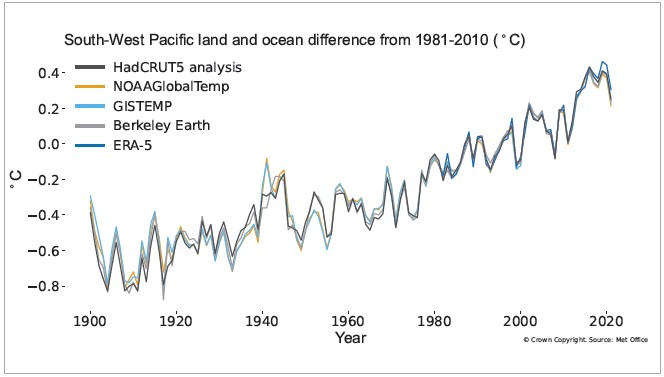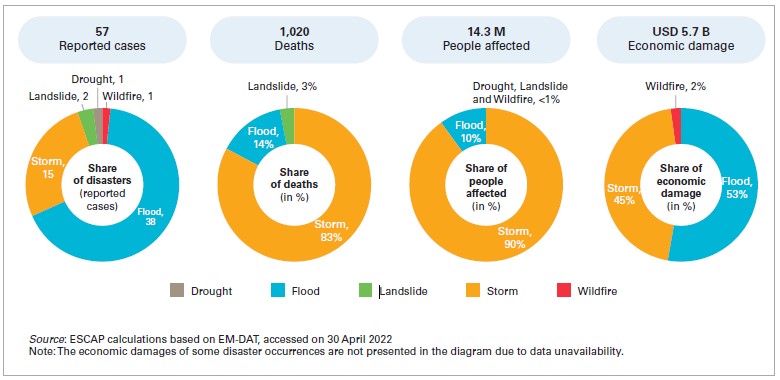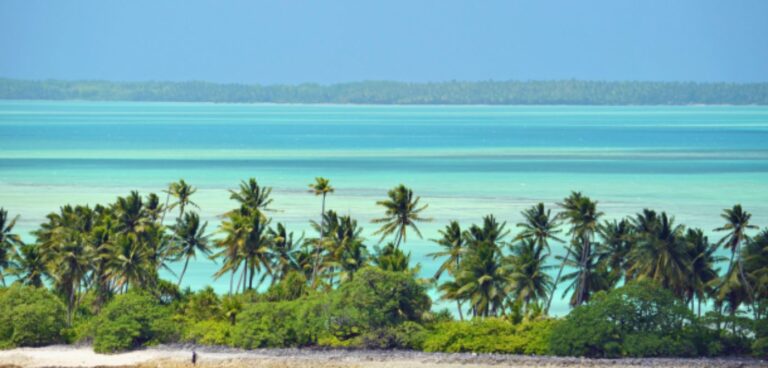The WMO’s State of Climate in South-West Pacific report and an accompanying story map were launched at the United Nations Climate Change negotiations, COP27, on November 17, 2022.
According to the report, sea surface temperatures and ocean heat in parts of the South West Pacific are increasing at more than three times the global average and harming vital ecosystems, while sea level rise poses an existential threat to low-lying islands and their people. Pacific Island delegates, therefore, stressed the need to keep temperatures to the 1.5°C lower limit of the Paris Agreement.
The State of the Climate in the South-West Pacific 2021 recorded how weather-related disasters are undermining socio-economic development, and threatening health, food and water security. It aimed to provide a snapshot of climate indicators like temperatures, sea level rise, ocean heat and acidification and extreme weather, alongside risks and impacts.

The report revealed that temperatures in the region were cooler than the previous few years largely because of a La Niña event, which brought dry conditions in much of the equatorial Pacific, and wet conditions over parts of South-East Asia and Australia. However, this did not reverse the long-term warming trend or slow other climate change impacts like the melting of glaciers.
In 2021, the region reported 57 natural hazards, 93% of which were floods and storms. Overall, 14.3 million people were directly affected by these disasters, causing total economic damage of US$5.7bn. Economic damage from storms has increased by 30% and more than doubled for floods, compared to the past two decades.
However, despite being on the frontline of climate change, many countries in the South West Pacific region don’t have enough tools to adapt. There are reportedly big gaps in observing systems and early warning services. The region is therefore one of the priority targets of a new UN Early Warnings for All initiative to ensure that everyone on Earth is protected in the next five years.
Prof. Petteri Taalas, Secretary-General, WMO, said, “The present report shows that sea-level rise has continued in the region. Given that there are many island countries in the region and most large cities are in coastal zones, this trend could exacerbate vulnerabilities in the region with respect to storm surges, coastal inundation and erosion, food and water security, and ultimately habitability and sustainability of the region.”
Armida Salsiah Alisjahbana Under-Secretary-General of the United Nations and Executive Secretary of the Economic and Social Commission for Asia and the Pacific, said, “The ‘riskscape’ of the South-West Pacific is expanding and intensifying with climate change, combined with further challenges emanating from our ongoing mission of Covid-19 recover.”
In terms of countries, Australia was observed to have suffered the highest proportion of economic losses due to floods in the region (US$2.5bn), followed by New Zealand (US$247m), and Malaysia (US$200m). However, the researchers emphasized that this is not proportionate to GDP. The ESCAP Asia-Pacific Disaster Reports 2021 and 2022 estimate that in the South-West Pacific, investments in adaptation would need to be highest in Indonesia, at US$8.8bn, followed by the Philippines at US$5.5bn. As a percentage of the country’s GDP, the highest cost is estimated for Vanuatu at 9.6%, followed by Tonga at 8.6%.
Alisjahbana continued, “Given that floods and tropical cyclones account for the highest economic losses, adaptation investment must be directed towards prioritizing anticipatory action and preparedness for these events. New infrastructure needs to be made more resilient, alongside improvements in water resources management and dryland agriculture crop production, while nature-based solutions bring durable and wide-ranging benefits. Investing in these solutions would also ensure progress on Sustainable Development Goals.”
The tropical cyclone season was recorded at slightly below average overall in the western North Pacific and close to average in terms of total numbers of tropical cyclones in both the Australian and South Pacific regions. Among tropical cyclones in the region, Seroja was reported as the most significant cyclone in the southern hemisphere in 2021, bringing severe damage to Indonesia and Australia. Tropical Cyclone Rai also brought damage to the Philippines.

[caption: Overview of 2021 disasters in the South-West Pacific region Credit – WMO
The WMO’s report highlighted how tropical cyclones with strong winds and heavy rainfall destroyed many of the small-hold farms and individual gardens upon which around 80% of all Pacific Islanders rely for agricultural produce, thereby contributing to increased food insecurity in the region. The researchers found that Kiribati and Tuvalu, where annual rainfall was widely less than 50% of average, were the worst affected by drought, while the Federated States of Micronesia and the Republic of the Marshall Islands also experienced significant drought at times.
To see the WMO’s accompanying video for this report, click here.



